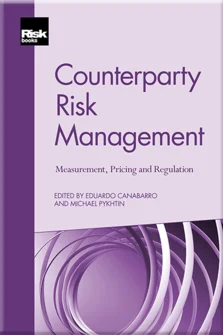American Monte Carlo: A Practitioner Approach
Giovanni Cesari
The Basel III Enhancements to Counterparty Risk Capital Charges
The Regulation of Counterparty Risk in Over-the-Counter Derivatives Markets
The Non-Internal Model Method for Counterparty Credit Risk
On Credit Valuation Adjustments and Regulatory Capital
American Monte Carlo: A Practitioner Approach
Best Market Practice for Calculation and Reporting of Wrong-Way Risk
Central Counterparty Risk
CVA Risk Management Post-Crisis
Re-Thinking CVA: Valuations, Counterparty Credit Risk and Model Risk
Should Derivatives Dealers Make A Funding Value Adjustment?
Adjoint Algorithmic Differentiation: Real-Time Counterparty Credit Risk Management in Monte Carlo Simulations
Stress Test of Counterparty Risks and Dynamic Hedging of the CVA
Dynamic Stress Testing of Counterparty Default Risk
Collateral: Modelling, Pricing and Optimisation

Since the 2007–9 global financial crisis there has been growing interest from financial institutions and regulators in computing, monitoring and possibly hedging or optimising counterparty credit exposure, credit valuation adjustment (CVA), risk weighted assets (RWA) and funding valuation adjustment (FVA). All these quantities can be obtained from transformations of price distributions computed at different time steps, from trade inception to maturity. As CVA, RWA and FVA need to be evaluated at portfolio level rather than at trade level, analytics are in general based on Monte Carlo simulations.
Conceptually, there are two steps in computing price distributions by Monte Carlo: simulation followed by pricing. In Figure 5.1 we show a schematic view of this approach. First, we need to simulate scenarios from the distribution of the underlying processes that drive the price of the products concerned. Second, the prices of these products need to be evaluated at each time step in the simulation schedule for each of the simulated scenarios.
The choice of models for generating scenarios requires a balance between sophistication for exotics products and simplicity to facilitate use
Copyright Infopro Digital Limited. All rights reserved.
As outlined in our terms and conditions, https://www.infopro-digital.com/terms-and-conditions/subscriptions/ (point 2.4), printing is limited to a single copy.
If you would like to purchase additional rights please email info@risk.net
Copyright Infopro Digital Limited. All rights reserved.
You may share this content using our article tools. As outlined in our terms and conditions, https://www.infopro-digital.com/terms-and-conditions/subscriptions/ (clause 2.4), an Authorised User may only make one copy of the materials for their own personal use. You must also comply with the restrictions in clause 2.5.
If you would like to purchase additional rights please email info@risk.net











